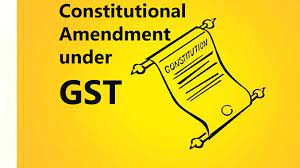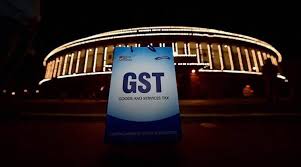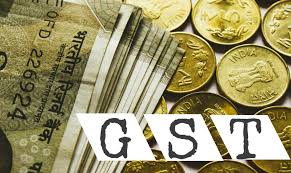CONSTITUTIONAL ASPECTS OF GST
The constitutional aspects of GST is as follows:

TAX STRUCTURE BEFORE GST
- Before the implementation of GST, taxation laws between the Centre and states were clearly demarcated. There were no overlaps between the fiscal powers, whatsoever. The Centre would levy tax on goods manufacture, except alcohol for consumption, narcotics, opium, etc.
- The states had the power to charge tax on the sale of goods.
- The Centre would levy the Central Sales Tax that was collected by the originating states.
- The Centre was also levying service tax on all types of services.
- Additionally, the Centre was charging and collecting additional duties of customs on goods that were imported into or exported from India. This tax was levied in addition to the Basic Customs Duty. This additional duty of customs is referred to as Countervailing Duty (CVD) and Special Additional Duty (SAD) and it counter balances excise duties, state VAT, sales tax, and other such taxes.
The introduction of the GST regime made amendments to the Constitution so that the Centre and states are empowered at the same time to levy and collect GST. This concurrent jurisdiction of the states and Centre also requires an institutional mechanism that ensures joint decisions are taken about the structure and operation of GST.
CONSTITUTION (122ND AMENDMENT) BILL, 2014

The Union Government in third week of December, 2014 (19 December, 2014) introduced Constitution (122nd Amendment) Bill, 2014 in Parliament which when passed shall pave the way for introduction of proposed Goods and Service Tax (GST) in India. This is an improvised version of lapsed 115th Amendment Bill of 2011.
Contrary to the general perception amongst many quarters that this Bill itself is a GST Bill, let it be very clearly understood that this is not a GST Bill. In fact, GST Bill is not in sight at all at this point in time. What has been introduced is only the Constitutional Amendment Bill enabling or empowering the union Government to levy a tax to be called GST which it cannot levy under the present Constitution. The Bill on passage would enable the Central Government and the State Governments to levy GST. This tax (GST) shall be levied concurrently by various states as well as Union Government. Once this is passed by two-third majority in the Parliament, atleast 50 per cent of the states will have to pass it. Once this amendment is through, the road will be clear for GST Bill (and then Act), given the political will. Eventually, we will then have the following taxes –
- National level GST [Central GST (CGST) and Inter-state GST (IGST)]
- State Level GST (SGST)
SALIENT FEATURES OF CONSTITUTION (ONE HUNDRED AND TWENTY-SECOND AMENDMENT) BILL, 2014

The Constitution (One Hundred and Twenty-Second Amendment) Bill, 2014 was introduced in the Lok Sabha on December 19, 2014. The following is the gist of amendments proposed by this Bill:
- The Bill seeks to amend the Constitution to introduce the goods and services tax (GST). Consequently, the GST subsumes various central indirect taxes including the Central Excise Duty, Additional Excise Duties, Service Tax, Additional Customs Duty (CVD) and Special Additional Duty of Customs (SAD), etc. It also subsumes state Value Added Tax (VAT)/Sales Tax, Central Sales Tax, Entertainment Tax, Octroi and Entry Tax, Purchase Tax and Luxury Tax, etc.
- Concurrent powers for GST: The Bill inserts a new Article 246A in the Constitution to give the central and state governments the concurrent power to make laws on the taxation of goods and services
- Integrated GST (IGST): However, only the centre may levy and collect GST on supplies in the course of inter-state trade or commerce. The tax collected would be divided between the centre and the states in a manner to be provided by Parliament, by law, on the recommendations of the GST Council.
- GST Council: The President must constitute a Goods and Services Tax Council within sixty days of this Act coming into force. The GST Council aim to develop a harmonized national market of goods and services.
- GST council examines issues relating to goods, services tax and make recommendations to the Union, and the States on parameters like rates, exemption list and threshold limits. The Council shall function under the Chairmanship of the Union Finance Minister and will have the Union Minister of State in charge of Revenue or Finance as member, along with the Minister in-charge of Finance or Taxation or any other Minister nominated by each State Government.
- Composition of the GST Council: The GST Council is to comprise of the following three members / class of members:
- The Union Finance Minister (as Chairman),
- The Union Minister of State in charge of Revenue or Finance, and
- The Minister in charge of Finance or Taxation or any other, nominated by each state government.
- Functions of the GST Council: These include making recommendations on:
- Taxes, cess and surcharges levied by the centre, states and local bodies which may be subsumed in the GST;
- Goods and services which may be subjected to or exempted from GST;
- Model GST laws, principles of levy, apportionment of IGST and principles that govern the place of supply;
- The threshold limit of turnover below which goods and services may be exempted from GST;
- Rates including floor rates with bands of GST;
- Special rates to raise additional resources during any natural calamity;
- Special provision with respect to Arunachal Pradesh, Jammu and Kashmir, Manipur, Meghalaya, Mizoram, Nagaland, Sikkim, Tripura, Himachal Pradesh and Uttarakhand; and
- Any other matters relating to the goods and services tax, as the Council may decide.
- The Goods and Service Tax Council shall recommend the date from which the goods and service tax be levied on petroleum crude, high speed diesel, motor spirit (commonly known as petrol), natural gas and aviation turbine fuel.
- Resolution of disputes: The GST Council may decide upon the modalities for the resolution of disputes arising out of its recommendations.
- Restrictions on imposition of tax: The Constitution imposes certain restrictions on states on the imposition of tax on the sale or purchase of goods. The Bill amends this provision to restrict the imposition of tax on the supply of goods and services and not on its sale.
- Additional Tax on supply of goods: An additional tax (not to exceed 1%) on the supply of goods in the course of inter-state trade or commerce would be levied and collected by the centre. Such additional tax shall be assigned to the states for two years, or as recommended by the GST Council.
- The net proceeds of additional tax on supply of goods in any financial year, except the proceeds attributable to the Union territories, shall not form part of the Consolidated Fund of India and be deemed to have been assigned to the States from where the supply originates.
- Compensation to states: Parliament may by law provide for compensation to states for revenue losses arising out of the implementation of the GST, on the GST Council’s recommendations. This would be up to a five-year period.
- The Government of India may where it considers necessary in the public interest, exempt such goods from the levy of tax.
- Both Centre and States will simultaneously levy GST across the value chain. Centre would levy and collect Central Goods and Services Tax (CGST), and States would levy and collect the State Goods and Services Tax (SGST) on all transactions within a State.
- The Centre would levy and collect the Integrated Goods and Services Tax (IGST) on all inter-State supply of goods and services. There will be seamless flow of input tax credit from one State to another. Proceeds of IGST will be apportioned among the States.
- GST will be a destination-based tax. All SGST on the final product will ordinarily accrue to the consuming State.
SEPTEMBER 2016
A Goods and Services Tax Council (GSTC) was created by the union finance minister, revenue minister, and ministers of state to take decisions on GST rates, thresholds, taxes to be subsumed, exemptions, and other features of the taxation system. The state finance ministers mentioned that the EC would be a platform for states where there would be discussions of their regional issues. The GST Council is a separate entity that would oversee the implementation of the GST system.
DECISIONS TAKEN BY GST COUNCIL
Some of the major decisions taken by the GSTC so far are:
- There would be four tax rates under the GST regime, i.e., 5%, 12%, 18%, and 28%. Some goods and services were also classified as exempt from tax.
- A cess above the peak rate of 28% would be levied on certain sin and luxury goods.
- The administrative control over 90% of taxpayers with turnover less than Rs.1.5 crore would be with the State tax administration. 10% of control would be with the Central tax administration.
- Administrative control over taxpayers having turnover above Rs.1.5 crore would be equally divided between the State and Centre tax administration.

